You indeed have plenty of options when you need network equipment such as Ethernet cables. But, a randomly picked Ethernet cable cannot provide you with optimized network speed or performance. Focusing on the case of Ethernet cables, you have to choose between Cat 6, Cat 7, and Cat 8 cables. While you can find all these cables in the market, they are made for different needs. In this guide, we have explained the major differences.
Choosing Ethernet Cables Between Cat 6, Cat 7, and Cat 8
Cat 6 Ethernet cables are the most affordable option among the three. However, compared to the transfer speed of 10Gbps of Cat 6 cables, Cat 8 cables offer an upgrade of up to 40Gbps. Cat 8 cables also offer additional shielding for improved performance. It is better to avoid Cat 7 cables.
The Basic Differences: Cat 6 vs. Cat 7 vs. Cat 8
Cat 6 Ethernet Cables
Cat 6 Ethernet cables are also known as Category 6 Ethernet cables. As you can guess from the name, it represents the sixth generation of standardized Ethernet cables that were introduced back in the early years of the 2000s. Even after almost 25 years, Cat 6 cables remain a popular choice for residential Ethernet and other networking needs. These cables were a significant improvement from Cat 5 and Cat 5e cables but are backwards-compatible with both.

Cat 7 Ethernet Cables
Cat 7 Ethernet cables are also known as Category 7 Ethernet cables. Contrary to popular belief, Cat 7 cables are not the direct successor of the Cat 6 cables. Instead, Cat 7 used a proprietary connection alongside better shielding properties. The objective was to increase the total distance for networks while maintaining higher data transfer needs. Since its introduction in 2002, Cat 7 has been critiqued for some points, making it a not-so-popular option for many needs.

Cat 8 Ethernet Cables
Cat 8 Ethernet cables, also known as Category 8 Ethernet cables, are the current standards for Ethernet and other forms of networking. Having been released in 2016, Cat 6 cables are a relatively new entry to cabling codes for Ethernet connections. It is also one of the first cabling standards to offer incredible speeds and shielding, without needing a proprietary connection. For the same reasons, Cat 8 cables have remained the go-to pick for high-intensity cabling needs.

Cat 6 vs. Cat 7 vs. Cat 8: Transfer Speeds
Now, I will look at the differences in transfer speeds on these cabling standards. We have to understand that these limits are theoretical, and the actual speed will depend a lot on multiple situational variables.
Cat 6 Ethernet cables have a maximum data transfer rate of 10Gbps, with a distance limit of 55 meters. These cables are thus a popular option for home networking needs, where you need medium-level speed for inter-device data transfer. Standard Cat 6 cables ship without shielding, making them a less recommended choice for outdoor networking setups.
Cat 7 Ethernet cables offer the same data transfer rate of 10Gbps but almost double the distance to 100M. More importantly, these cables are equipped with built-in shielding options, making them suitable for both indoor and outdoor networking needs. However, the proprietary connector of Cat 7 cables has prevented it from being a popular choice.
Cat 8 Ethernet cables improve the data transfer rate by 4 times, pushing it to 40 Gbps. The maximum length of the cable can be up to 30 meters. Therefore, Cat 8 cables are the fastest options you can find in terms of data transfer speed. All these cables come with built-in shielding options and offer almost double the power while connecting to Power-over-Ethernet devices.
In short, you have to choose between Cat 6 and Cat 8 cables if you are looking for the best speed. If you want to future-proof your network while leaving room for more devices, you should choose Cat 8 cables.
Cat 6 vs. Cat 7 vs. Cat 8: Compatibility
Compatibility is also a big concern when you choose Ethernet cables for your network. These cables should work with the standard ports and connectors in a network environment. Otherwise, you should be ready to pay for proprietary connectors, which can be an additional expense.
Cat 6 Ethernet cables remain one of the most compatible options you can find in the market right now. The standard connector is RJ45, meaning that you can use it with almost every networking device out there. The best part is that legacy devices are also supported by the standard.
Cat 7 Ethernet cables are on the opposite side of the spectrum. As we mentioned earlier, it uses a proprietary connection for maximum speeds. Therefore, despite its backward compatibility with RJ45 cables, Cat 7 cables would not make a difference unless you use it with a proprietary connector. This proprietary connector has not been widely adopted either. Therefore, if you are worried about compatibility, you should stay away from Cat 7 cables in general.
Cat 8 Ethernet cables bring the best of both worlds. While these cables offer the maximum speed, they don’t make compromises on the compatibility front. Because these cables make use of an RJ45 connector, you would not have trouble connecting to all types of networking devices. Regardless of whether these devices can support up to 40 Gbps of data transfer rate, you can have them working in sync within the network.
Once again, the choice narrows down to Cat 6 and Cat 8 cables. Because both offer the same level of network compatibility, you can pick one based on your data transfer and bandwidth requirements.
Cat 6 vs. Cat 7 vs. Cat 8: Shielding
If you are planning to set up an outdoor network, or you have many devices within the vicinity, you might also want to check the shielding options.
Because they were introduced back in the 2000s, Cat 6 Ethernet cables do not offer built-in shielding options. You might be able to pay an additional amount for additional shielding, but that is about it. Therefore, the unshielded nature of Cat 6 cables makes them a secondary option for complex networks.
Cat 7 cables overcame the shielding limitation because you can purchase shielded variants of these cables. The maximum distance of 100 meters is also impressive from an outdoor networking point of view. But once again, the proprietary connector makes it a difficult choice to integrate with most networking equipment.
Even though Cat 8 Ethernet cables do not have the highest maximum length, all these cables are shielded. It means you can pick any of the Cat 8 cables and use them in different networking environments without any impact on the speed. The shielding is also done due to the higher amount of power it carries on all cables.
Therefore, if you are worried about shielding, you can simply go for Cat 8 Ethernet cables.
Cat 6 vs. Cat 7 vs. Cat 8 Cables: Pricing
We will quickly tell you how the pricing of these cables is different.
Out of the three options, Cat 6 Ethernet cables are the most affordable option you can find in the market. If you are looking for a 100-foot cable, you can find it for approximately $30 on the market. On the other hand, Cat 7 cables are not a popular option, and they cost a little more than Cat 6 cables. So you would have to pay around $40 for the cable but then deal with the issues of proprietary connectors. And from that perspective, it makes sense to go for Cat 8 Ethernet cables, for which you will have to pay around $60 or $70. But we have to keep in mind that all these cables are shielded and offer advanced power capabilities, which add to the investment.
Therefore, unless you are very particular about the transfer speeds, you can choose between Cat 6 or Cat 8 Ethernet cables.
Use Cases for Cat 6, Cat 7, Cat 8 Cables
I hope you understand the potential advantages and disadvantages of Cat 6, Cat 7, and Cat 8 Ethernet cables from the above sections. Now we will look at the ideal use cases for these cable types.
For Cat 6 Cables
Cat 6 Ethernet cables are mostly used for home networking needs. Because they do not come with shielding, they are much suited for indoor networking. At the same time, these cables can offer a maximum speed of 10Gbps within a maximum distance of 55 meters, which is pretty great for most home networks. I would even go to the extent of using Cat 6 cables for a mini office setup.
For Cat 7 Cables
Cat 7 cables are not used in standard networking scenarios. The problem is with the proprietary connector itself. Some organizations may use the connector and the cable standard for their own needs, but I don’t recommend this for home networking or office networking. If you go with this standard, you should be able to pay for the additional expenses that may come up.
For Cat 8 Cables
Cat 8 cables are the best option you have when it comes to advanced home networks and all sorts of professional networks. Using these cables for home networks can seem a little overkill, but it future-proofs the network for at least 5 years to come. On the contrary, with professional networks, you need Cat 8 cables, not only because of their high transfer speed but also because of the shielding options you get.
Frequently Asked Questions
Cat 8 Ethernet cables are better than Cat 6 Ethernet cables because they were launched almost 20 years apart. Therefore, Cat 8 cables offer better transfer speeds of up to 40Gbps, whereas Cat 6 cables are restricted to 10Gbps. More importantly, Cat 8 cables can improve the overall network performance due to their shielded nature.
So, unless you have an ancient Wi-Fi router, you should find them working fine with Cat 8 cables. Then again, since Cat 8 cables have backward compatibility with older standards, you would not have trouble connecting these cables to an older router cable. But you have to get an advanced router if you want to make use of the maximum speed and network efficiency.
Conclusion
I have covered almost everything you should know about the differences between Cat 6, Cat 7 and Cat 8 cables. Of course, I have looked at these cables from an Ethernet point of view. Therefore, you might have other concerns if you are looking for an advanced connection of some sort.
Similarly, the choices in this article are highlighted from a home network or office networking point of view. The experience might be different if you want to create a wide area network, where efficiency and speed take different roles.
On a strictly personal note, I think everyone should go for Cat 8 cables unless they are expensive. Cat 6 cables may work in the end, but the lack of future-proofing means you will have to upgrade your network in due time. And it is better to do it now than within 2 or 5 years.